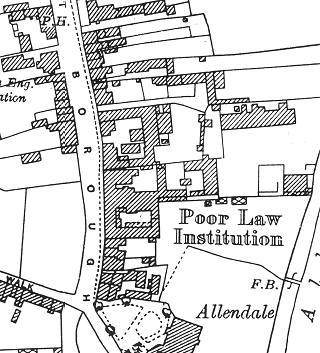Wimborne and Cranborne, Dorset
Up to 1834
In 1750, a parish workhouse was erected on East Borough, Wimborne, now the site of Allen Court. It was enlarged in the 1760s and in 1777 was reported as being able to house up to 200 inmates. In 1784, its running was contracted out to Richard Mitchell, who was paid 1s. 9d. a week for each inmate. A dining room was added to the premises in 1815. In 1817, a Mr John Gouger proposed setting up a silk-winding business, with labour provided by children and other inmates from the workhouse.
In 1777, a parish workhouse was in operation at Cranborne which could hold up to 60 inmates.
After 1834
Wimborne and Cranborne were initially created as independent Poor Law Unions in 1835, but were merged to form a single Wimborne and Cranborne Union in October of the following year. The details of each union at the time of its original formation are given below.
Cranborne Union
Cranborne Union formally came into existence on 30th September 1835. Its operation was overseen by an elected Board of Guardians, 17 in number, representing its 14 constituent parishes as listed below (figures in brackets indicate numbers of Guardians if more than one):
Dorset: Chettle, Cranborne (3), Edmondesham [Edmondsham], Farnham, Gussage All Saints, Gussage St Michael, Horton, Long Critchell [Crichell], More Critchell [Crichell], Pentridge, Sixpenny Handley (2), Tollard Farnham, Wimborne St Giles, Woodland.
The population falling within the Cranborne Union at the 1831 census had been 6,278 with its parishes ranging in size from Farnham (population 94) to Cranborne itself (2,158). The average annual poor-rate expenditure for the period 1833-35 had been £6,278 or 11s.3d. per head of the population.
Wimborne Union
Wimborne Union formally came into existence on 28th September 1835. Its operation was overseen by an elected Board of Guardians, 13 in number, representing its 10 constituent parishes:
Dorset: Chalbury, Corfe Mullen, Hampreston, Hinton Martell, Hinton Parva, West Parley, Shapwicke, Sturminster Marshall, Wimborne Minster (4), Witchampton.
The population falling within the Wimborne Union at the 1831 census had been 7,933 with its parishes ranging in size from Hinton Parva (population 36) to Wimborne Minster (4,009). The average annual poor-rate expenditure for the period 1833-35 had been £4,879 or 12s.4d. per head of the population.
Wimborne and Cranborne Union
Later additions to Wimborne & Cranborne Union: Alderholt (from 1894), Almer (from 1894), Colehill (from 1896), Holt (from 1894), Pamphill (from 1894), Verwood (from 1894), East Woodyates (from 1858).
In 1836, the Poor Law Commissioners authorised the expenditure of up to £1,000 on the enlargement of the existing Wimborne parish workhouse. A further £105.8s.0d. was approved in the following year, and another £450 in 1838. However, this expenditure was clearly inadequate. In 1839, Assistant Poor Law Commissioner Colonel A'Court visited the workhouse to investigate a smallpox outbreak. He found that in one room, thirteen people were sleeping in five beds "although many of the beds were double beds and many of the persons sleeping in them were young children , and only three above the age of sixteen years". The story resulted in a public scandal with the workhouse surgeon Dr George Place eventually taking the blame. However, no further improvements were actually made to the buildings until 1868.
The workhouse building was a two-storey brick building with tiled roofs. The central section had a T-shaped layout of two storeys, topped by a bell turret. In the stem of the T were the Master's parlour on the ground floor and his bedroom above. The workhouse location and layout are shown on the 1928 map by which time it had become officially known as a Poor Law Institution.

Wimborne and Cranborne site, 1928.
After 1930, the workhouse became a Public Assistance Institution and was renamed Allen View House. The buildings were demolished in 1958 and replaced by Allen Court.
Staff
Inmates
Records
Note: many repositories impose a closure period of up to 100 years for records identifying individuals. Before travelling a long distance, always check that the records you want to consult will be available.
- Dorset History Centre, Bridport Road, Dorchester DT1 1RP. Relatively few local records survive. Holdings include: Guardians' minute books (1835-1930); Ledgers (1927-30); Baptisms register (1839-1914, 1920, 1929); etc.
Bibliography
- Dorset Workhouses Countryside Treasures Survey (Dorset County Council, 1979).
Links
- None.
Unless otherwise indicated, this page () is copyright Peter Higginbotham. Contents may not be reproduced without permission.


